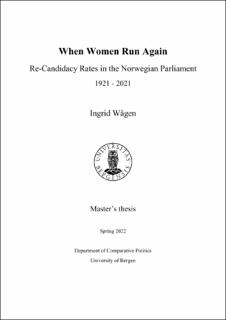When Women Run Again. Re-Candidacy Rates in the Norwegian Parliament 1921 - 2021
Master thesis
Permanent lenke
https://hdl.handle.net/11250/3011186Utgivelsesdato
2022-06-22Metadata
Vis full innførselSamlinger
Sammendrag
Research on gendered patterns of political representation has grown drastically over the last couple of decades. At the same time, the existing research and literature on this field has primarily focused on the numbers of male and female MPs and the barriers to run for election (Schwindt-Bayer 2005; Norris 2006). However, ensuring that women are represented on equal footing with men requires more than just their presence in parliaments. Some studies indicate that gendered dynamics of political institutions might make women leave politics earlier and at higher rates than men. If women MPs have higher turnover rates than their men colleagues, they will have smaller political influence and power. This thesis therefore aims to empirically investigate whether there are indeed gendered differences in politicians’ choice to run again as electoral candidates in order to fill a research gap on female representation. By investigating the research in the field of political careers and re-candidacy, and by building a theoretical framework based on Stein Rokkan's threshold theory, I develop three conditional hypotheses about gender differences in re-candidacy rates. Utilizing logistical regression models, the master's thesis provides evidence that re-candidacy varies between genders. I find that there is a negative effect of being a female candidate on the probability of re-running. The negative effect of being female stays significant at the 1% significance level even when controlling for time trends, incumbency, list ranking and with including fixed effects on district and political party. Still, findings also show that the gender differences in the probability of re-running decrease over time and has now, towards the beginning of the second decade of the 2000s, become insignificant. Furthermore, the observed gender differences are mostly driven by unsuccessful candidates. Unsuccessful meaning candidates that loose elections. In this pool, unsuccessful men are significantly more likely than unsuccessful women to re-run for election. The gender differences between male and female candidates disappear when comparing incumbents’ probability to run again.
